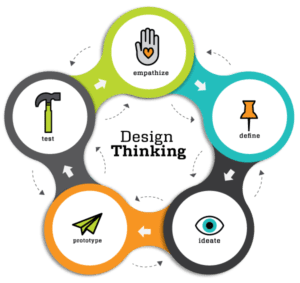Design is all around us.
Technologists like those attending this week’s ASAE Tech event in National Harbor, MD may prioritize the underlying tools and systems bringing their organization to life for members, but design plays a critical role. Good design has a powerful effect on a user’s experience, judgement and behavior. If the experience is a poor one, they won’t come back. For association professionals, the risks introduced by poor design have a significant impact for member engagement and retention.
The good news is design thinking isn’t about design, it’s about thinking.

Source: ideatehighacademy.com
Opening their ASAE Tech session, Master Design Thinking to Capitalize on Unmet Member Needs, Bean Creative’s Layla Masri and Katherine Matthews of the National Council of Architectural Registration Boards (NCARB) positioned design thinking as accessible and highly relevant to all areas of an association.
How to get started. Design thinking, according to the Interaction Design Foundation is not a linear process but is completely attainable. Similar to another session covered for this blog, 4 Steps to Digital Marketing Transformation, this session appealed to the common sense of attendees while challenging them to try new things as well:
Empathize
Associations are in the business of relationships and empathy should come naturally…right? While the ongoing dialogue created as part of membership is helpful, it doesn’t replace the activities necessary to build an understanding an appreciation for a member’s experience with your organization. Take the time to interview members specific to what you want to learn, going beyond rapport to evoke stories, explore emotions and question their responses.
What happens when you design without empathy? Marsi and Matthews offered the example of Google Glass and this quote from MIT Technology Review as a cautionary tale, “No one could understand why you’d want to have that thing on your face, in the way of normal social interaction.”
Define
With user interviews complete, synthesize the feedback into concise problem statements that help you home in on the problems that design may help you address. Ensure they’re human-centered and broad enough to allow for creativity but narrow enough to ensure they get done. To write problem statements, articulate:
- What problem are we trying to solve?
- How do we know this is a real problem?
- Why is it important to solve?
- Who are our users? What are their goals and motivations?
- How will we know if we’ve solved the problem?
Ideate
The fun part of the design process for many, ideation is where an organization takes the time to imagine potential solutions to their problems. In designing creative solutions to their stated problem, an organization may question an assumption, change a perception, play devil’s advocate, engage an unexpected resource or break the problem into smaller, more addressable pieces.
Prototype
In today’s fast-moving world, prototyping has become part of everyday operations for many organizations, especially within their IT and marketing departments. But prototyping provides value when applying design thinking to larger challenges as well. How can you improve post-event engagement? How can you create a meaningful, high-impact member onboarding process? Creative thinking is encouraged but constraints are introduced to ensure final options are desirable, feasible and viable. And prototyping is intended to be fast – the session suggested a rapid approach, where teams were challenged to create 100 solutions in only 10 minutes!
Test
With a prototype solution ready it’s time to set it live. Your team thinks their application of design thinking will solve your problem statement but will your members feel that way?
As mentioned, design thinking is a non-linear process and at every stage there are opportunities to stop, revisit previous decisions and adjust to better understand the problems facing members but also to ensure the designed solution you’re introducing is the right one. Testing isn’t the end of the process but a new beginning, with opportunities to learn more about users, validate your definition of their problems and generate a new batch of ideas to carry your organization forward.
In their session, Marsi and Matthews shared a quote from American investor Charles Kettering, “A problem well-stated is half solved.” Design thinking not only provides the framework for an immediate solution but for an ongoing culture of transparency and rich understanding that will fuel excellence for years to come.
